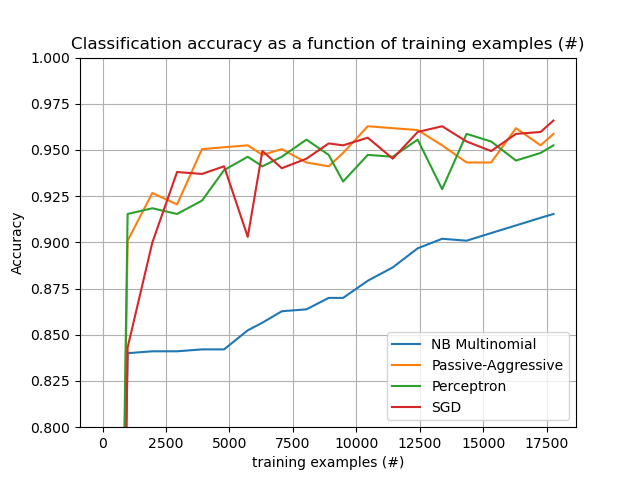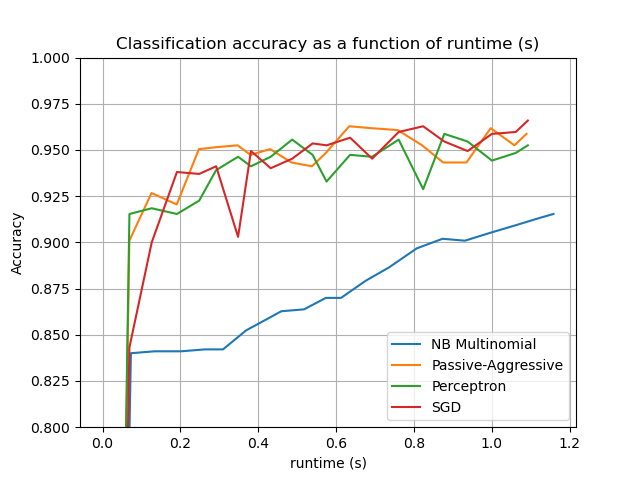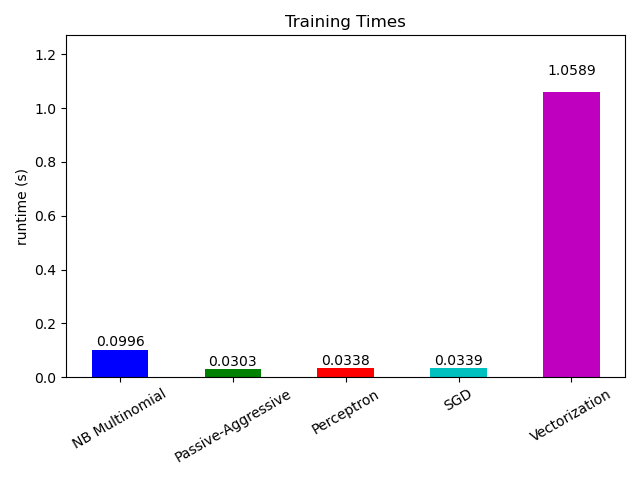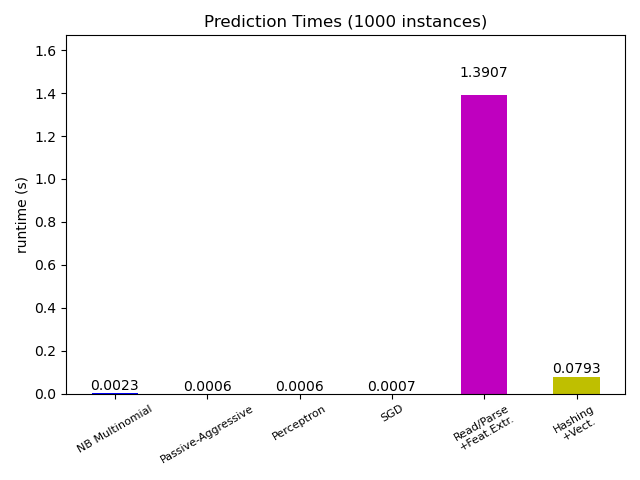Note
Click here to download the full example code or to run this example in your browser via Binder
Out-of-core classification of text documents¶
This is an example showing how scikit-learn can be used for classification using an out-of-core approach: learning from data that doesn’t fit into main memory. We make use of an online classifier, i.e., one that supports the partial_fit method, that will be fed with batches of examples. To guarantee that the features space remains the same over time we leverage a HashingVectorizer that will project each example into the same feature space. This is especially useful in the case of text classification where new features (words) may appear in each batch.
# Authors: Eustache Diemert <eustache@diemert.fr>
# @FedericoV <https://github.com/FedericoV/>
# License: BSD 3 clause
from glob import glob
import itertools
import os.path
import re
import tarfile
import time
import sys
import numpy as np
import matplotlib.pyplot as plt
from matplotlib import rcParams
from html.parser import HTMLParser
from urllib.request import urlretrieve
from sklearn.datasets import get_data_home
from sklearn.feature_extraction.text import HashingVectorizer
from sklearn.linear_model import SGDClassifier
from sklearn.linear_model import PassiveAggressiveClassifier
from sklearn.linear_model import Perceptron
from sklearn.naive_bayes import MultinomialNB
def _not_in_sphinx():
# Hack to detect whether we are running by the sphinx builder
return "__file__" in globals()
Main¶
Create the vectorizer and limit the number of features to a reasonable maximum
vectorizer = HashingVectorizer(
decode_error="ignore", n_features=2**18, alternate_sign=False
)
# Iterator over parsed Reuters SGML files.
data_stream = stream_reuters_documents()
# We learn a binary classification between the "acq" class and all the others.
# "acq" was chosen as it is more or less evenly distributed in the Reuters
# files. For other datasets, one should take care of creating a test set with
# a realistic portion of positive instances.
all_classes = np.array([0, 1])
positive_class = "acq"
# Here are some classifiers that support the `partial_fit` method
partial_fit_classifiers = {
"SGD": SGDClassifier(max_iter=5),
"Perceptron": Perceptron(),
"NB Multinomial": MultinomialNB(alpha=0.01),
"Passive-Aggressive": PassiveAggressiveClassifier(),
}
def get_minibatch(doc_iter, size, pos_class=positive_class):
"""Extract a minibatch of examples, return a tuple X_text, y.
Note: size is before excluding invalid docs with no topics assigned.
"""
data = [
("{title}\n\n{body}".format(**doc), pos_class in doc["topics"])
for doc in itertools.islice(doc_iter, size)
if doc["topics"]
]
if not len(data):
return np.asarray([], dtype=int), np.asarray([], dtype=int)
X_text, y = zip(*data)
return X_text, np.asarray(y, dtype=int)
def iter_minibatches(doc_iter, minibatch_size):
"""Generator of minibatches."""
X_text, y = get_minibatch(doc_iter, minibatch_size)
while len(X_text):
yield X_text, y
X_text, y = get_minibatch(doc_iter, minibatch_size)
# test data statistics
test_stats = {"n_test": 0, "n_test_pos": 0}
# First we hold out a number of examples to estimate accuracy
n_test_documents = 1000
tick = time.time()
X_test_text, y_test = get_minibatch(data_stream, 1000)
parsing_time = time.time() - tick
tick = time.time()
X_test = vectorizer.transform(X_test_text)
vectorizing_time = time.time() - tick
test_stats["n_test"] += len(y_test)
test_stats["n_test_pos"] += sum(y_test)
print("Test set is %d documents (%d positive)" % (len(y_test), sum(y_test)))
def progress(cls_name, stats):
"""Report progress information, return a string."""
duration = time.time() - stats["t0"]
s = "%20s classifier : \t" % cls_name
s += "%(n_train)6d train docs (%(n_train_pos)6d positive) " % stats
s += "%(n_test)6d test docs (%(n_test_pos)6d positive) " % test_stats
s += "accuracy: %(accuracy).3f " % stats
s += "in %.2fs (%5d docs/s)" % (duration, stats["n_train"] / duration)
return s
cls_stats = {}
for cls_name in partial_fit_classifiers:
stats = {
"n_train": 0,
"n_train_pos": 0,
"accuracy": 0.0,
"accuracy_history": [(0, 0)],
"t0": time.time(),
"runtime_history": [(0, 0)],
"total_fit_time": 0.0,
}
cls_stats[cls_name] = stats
get_minibatch(data_stream, n_test_documents)
# Discard test set
# We will feed the classifier with mini-batches of 1000 documents; this means
# we have at most 1000 docs in memory at any time. The smaller the document
# batch, the bigger the relative overhead of the partial fit methods.
minibatch_size = 1000
# Create the data_stream that parses Reuters SGML files and iterates on
# documents as a stream.
minibatch_iterators = iter_minibatches(data_stream, minibatch_size)
total_vect_time = 0.0
# Main loop : iterate on mini-batches of examples
for i, (X_train_text, y_train) in enumerate(minibatch_iterators):
tick = time.time()
X_train = vectorizer.transform(X_train_text)
total_vect_time += time.time() - tick
for cls_name, cls in partial_fit_classifiers.items():
tick = time.time()
# update estimator with examples in the current mini-batch
cls.partial_fit(X_train, y_train, classes=all_classes)
# accumulate test accuracy stats
cls_stats[cls_name]["total_fit_time"] += time.time() - tick
cls_stats[cls_name]["n_train"] += X_train.shape[0]
cls_stats[cls_name]["n_train_pos"] += sum(y_train)
tick = time.time()
cls_stats[cls_name]["accuracy"] = cls.score(X_test, y_test)
cls_stats[cls_name]["prediction_time"] = time.time() - tick
acc_history = (cls_stats[cls_name]["accuracy"], cls_stats[cls_name]["n_train"])
cls_stats[cls_name]["accuracy_history"].append(acc_history)
run_history = (
cls_stats[cls_name]["accuracy"],
total_vect_time + cls_stats[cls_name]["total_fit_time"],
)
cls_stats[cls_name]["runtime_history"].append(run_history)
if i % 3 == 0:
print(progress(cls_name, cls_stats[cls_name]))
if i % 3 == 0:
print("\n")
downloading dataset (once and for all) into /home/runner/scikit_learn_data/reuters
untarring Reuters dataset...
done.
Test set is 969 documents (155 positive)
SGD classifier : 988 train docs ( 122 positive) 969 test docs ( 155 positive) accuracy: 0.843 in 0.61s ( 1618 docs/s)
Perceptron classifier : 988 train docs ( 122 positive) 969 test docs ( 155 positive) accuracy: 0.915 in 0.61s ( 1611 docs/s)
NB Multinomial classifier : 988 train docs ( 122 positive) 969 test docs ( 155 positive) accuracy: 0.840 in 0.62s ( 1589 docs/s)
Passive-Aggressive classifier : 988 train docs ( 122 positive) 969 test docs ( 155 positive) accuracy: 0.901 in 0.62s ( 1583 docs/s)
SGD classifier : 3918 train docs ( 441 positive) 969 test docs ( 155 positive) accuracy: 0.937 in 1.62s ( 2419 docs/s)
Perceptron classifier : 3918 train docs ( 441 positive) 969 test docs ( 155 positive) accuracy: 0.923 in 1.62s ( 2416 docs/s)
NB Multinomial classifier : 3918 train docs ( 441 positive) 969 test docs ( 155 positive) accuracy: 0.842 in 1.63s ( 2404 docs/s)
Passive-Aggressive classifier : 3918 train docs ( 441 positive) 969 test docs ( 155 positive) accuracy: 0.950 in 1.63s ( 2400 docs/s)
SGD classifier : 6298 train docs ( 692 positive) 969 test docs ( 155 positive) accuracy: 0.949 in 2.52s ( 2499 docs/s)
Perceptron classifier : 6298 train docs ( 692 positive) 969 test docs ( 155 positive) accuracy: 0.941 in 2.52s ( 2497 docs/s)
NB Multinomial classifier : 6298 train docs ( 692 positive) 969 test docs ( 155 positive) accuracy: 0.857 in 2.53s ( 2490 docs/s)
Passive-Aggressive classifier : 6298 train docs ( 692 positive) 969 test docs ( 155 positive) accuracy: 0.947 in 2.53s ( 2488 docs/s)
SGD classifier : 8910 train docs ( 1014 positive) 969 test docs ( 155 positive) accuracy: 0.954 in 3.49s ( 2553 docs/s)
Perceptron classifier : 8910 train docs ( 1014 positive) 969 test docs ( 155 positive) accuracy: 0.947 in 3.49s ( 2552 docs/s)
NB Multinomial classifier : 8910 train docs ( 1014 positive) 969 test docs ( 155 positive) accuracy: 0.870 in 3.50s ( 2546 docs/s)
Passive-Aggressive classifier : 8910 train docs ( 1014 positive) 969 test docs ( 155 positive) accuracy: 0.941 in 3.50s ( 2544 docs/s)
SGD classifier : 11435 train docs ( 1361 positive) 969 test docs ( 155 positive) accuracy: 0.945 in 4.44s ( 2574 docs/s)
Perceptron classifier : 11435 train docs ( 1361 positive) 969 test docs ( 155 positive) accuracy: 0.946 in 4.44s ( 2572 docs/s)
NB Multinomial classifier : 11435 train docs ( 1361 positive) 969 test docs ( 155 positive) accuracy: 0.886 in 4.45s ( 2568 docs/s)
Passive-Aggressive classifier : 11435 train docs ( 1361 positive) 969 test docs ( 155 positive) accuracy: 0.962 in 4.45s ( 2567 docs/s)
SGD classifier : 14344 train docs ( 1676 positive) 969 test docs ( 155 positive) accuracy: 0.955 in 5.46s ( 2625 docs/s)
Perceptron classifier : 14344 train docs ( 1676 positive) 969 test docs ( 155 positive) accuracy: 0.959 in 5.46s ( 2624 docs/s)
NB Multinomial classifier : 14344 train docs ( 1676 positive) 969 test docs ( 155 positive) accuracy: 0.901 in 5.47s ( 2621 docs/s)
Passive-Aggressive classifier : 14344 train docs ( 1676 positive) 969 test docs ( 155 positive) accuracy: 0.943 in 5.47s ( 2620 docs/s)
SGD classifier : 17260 train docs ( 2066 positive) 969 test docs ( 155 positive) accuracy: 0.960 in 6.47s ( 2665 docs/s)
Perceptron classifier : 17260 train docs ( 2066 positive) 969 test docs ( 155 positive) accuracy: 0.948 in 6.48s ( 2664 docs/s)
NB Multinomial classifier : 17260 train docs ( 2066 positive) 969 test docs ( 155 positive) accuracy: 0.913 in 6.48s ( 2661 docs/s)
Passive-Aggressive classifier : 17260 train docs ( 2066 positive) 969 test docs ( 155 positive) accuracy: 0.953 in 6.49s ( 2660 docs/s)
Plot results¶
The plot represents the learning curve of the classifier: the evolution of classification accuracy over the course of the mini-batches. Accuracy is measured on the first 1000 samples, held out as a validation set.
To limit the memory consumption, we queue examples up to a fixed amount before feeding them to the learner.
def plot_accuracy(x, y, x_legend):
"""Plot accuracy as a function of x."""
x = np.array(x)
y = np.array(y)
plt.title("Classification accuracy as a function of %s" % x_legend)
plt.xlabel("%s" % x_legend)
plt.ylabel("Accuracy")
plt.grid(True)
plt.plot(x, y)
rcParams["legend.fontsize"] = 10
cls_names = list(sorted(cls_stats.keys()))
# Plot accuracy evolution
plt.figure()
for _, stats in sorted(cls_stats.items()):
# Plot accuracy evolution with #examples
accuracy, n_examples = zip(*stats["accuracy_history"])
plot_accuracy(n_examples, accuracy, "training examples (#)")
ax = plt.gca()
ax.set_ylim((0.8, 1))
plt.legend(cls_names, loc="best")
plt.figure()
for _, stats in sorted(cls_stats.items()):
# Plot accuracy evolution with runtime
accuracy, runtime = zip(*stats["runtime_history"])
plot_accuracy(runtime, accuracy, "runtime (s)")
ax = plt.gca()
ax.set_ylim((0.8, 1))
plt.legend(cls_names, loc="best")
# Plot fitting times
plt.figure()
fig = plt.gcf()
cls_runtime = [stats["total_fit_time"] for cls_name, stats in sorted(cls_stats.items())]
cls_runtime.append(total_vect_time)
cls_names.append("Vectorization")
bar_colors = ["b", "g", "r", "c", "m", "y"]
ax = plt.subplot(111)
rectangles = plt.bar(range(len(cls_names)), cls_runtime, width=0.5, color=bar_colors)
ax.set_xticks(np.linspace(0, len(cls_names) - 1, len(cls_names)))
ax.set_xticklabels(cls_names, fontsize=10)
ymax = max(cls_runtime) * 1.2
ax.set_ylim((0, ymax))
ax.set_ylabel("runtime (s)")
ax.set_title("Training Times")
def autolabel(rectangles):
"""attach some text vi autolabel on rectangles."""
for rect in rectangles:
height = rect.get_height()
ax.text(
rect.get_x() + rect.get_width() / 2.0,
1.05 * height,
"%.4f" % height,
ha="center",
va="bottom",
)
plt.setp(plt.xticks()[1], rotation=30)
autolabel(rectangles)
plt.tight_layout()
plt.show()
# Plot prediction times
plt.figure()
cls_runtime = []
cls_names = list(sorted(cls_stats.keys()))
for cls_name, stats in sorted(cls_stats.items()):
cls_runtime.append(stats["prediction_time"])
cls_runtime.append(parsing_time)
cls_names.append("Read/Parse\n+Feat.Extr.")
cls_runtime.append(vectorizing_time)
cls_names.append("Hashing\n+Vect.")
ax = plt.subplot(111)
rectangles = plt.bar(range(len(cls_names)), cls_runtime, width=0.5, color=bar_colors)
ax.set_xticks(np.linspace(0, len(cls_names) - 1, len(cls_names)))
ax.set_xticklabels(cls_names, fontsize=8)
plt.setp(plt.xticks()[1], rotation=30)
ymax = max(cls_runtime) * 1.2
ax.set_ylim((0, ymax))
ax.set_ylabel("runtime (s)")
ax.set_title("Prediction Times (%d instances)" % n_test_documents)
autolabel(rectangles)
plt.tight_layout()
plt.show()
Total running time of the script: ( 0 minutes 8.477 seconds)




